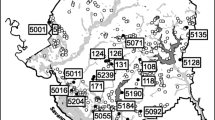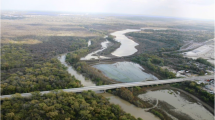Abstract
Wetlands in the Prairie Pothole Region of eastern North Dakota, USA are often overgrown with cattails (Typha spp), providing habitat crop-depredating blackbirds and impeding use by waterfowl. One and two years post-treatment (1992 and 1993), we assessed the response of invertebrates to a catastrophic reduction in cattail coverage caused by glyphosate, a herbicide applied to about 14,000 ha of North Dakota’s wetlands since 1991. Numbers of Crustacea, Hydracarina, Oligochaeta, Copepoda, Ostracoda, and Cladocera were similar between treated and reference wetlands (P≥0.10), while abundance of Gastropoda was greater in the treated wetlands (P=0.10). Insect abundance was greater in treated wetlands (P<0.01), with activity traps yielding highest numbers in July. Corixidae and Chironomidae were more abundant, in treated wetlands (P<0.10), whereas Chaoboridae was consistently more plentiful in the reference wetlands (P=0.05). Our results suggest that populations of some aquatic invertebrates may be enhanced by a reduction in cattail coverage with glyphosate-based herbicide.
Similar content being viewed by others
Literature Cited
Buhl, K. J. and N. L. Faerber. 1989. Acute toxicity of selected herbicides and surfactants to larvae of the midgeChironomus riparius. Archives of Environmental Contamination and Toxicology 18: 530–536.
Cody, R. P. and J. K. Smith. 1991. Applied Statistics and the SAS Programming Language. Third ed. Prentice Hall, Englewood Cliffs, NJ, USA.
Cole, G. A. 1983. Textbook of Limnology. Waveland Press, Inc., Prospect Heights, IL, USA.
Davis, C. B. and A. G. van der Valk. 1978. The decomposition of standing and faller litter ofTypha glauca andScirpus fluviatilis. Canadian Journal of Botany 56:662–675.
Folmar, L. C., H. O. Sanders, and A. M. Julin. 1979. Toxicity of the herbicide glyphosate and several of its formulations to fish and aquatic invertebrates. Archives of Environmental Contamination and Toxicology 8:269–278.
Henry, C. J., K. F. Higgins, and K. J. Buhl. 1994. Acute toxicity and hazard assessment of Rodeo®, X-77 Spreader®, and Chem-Trol® to aquatic invertebrates. Archives of Environmental Contamination and Toxicology 27:392–399.
Homan, H. J., G. M. Linz, L. E. Huffman, and W. J. Bleier. 1998. A summary of cattail-spraying operations in North Dakota: 1991–97. Proceedings of Sunflower Research Workshop 20:142–144.
Kaminski, R. M. and H. H. Prince. 1981a. Dabbling duck activity and foraging responses to aquatic macroinvertebrates. Auk 98:115–126.
Kaminski, R. M. and H. H. Prince. 1981b. Dabbling duck and aquatic macroinvertebrate responses to manipulated wetland habitat. Journal of Wildlife Management 45:1–15.
Kantrud, H. A. 1986. Effects of vegetation manipulation on breeding waterfowl in prairie wetlands-a literature review. U.S. Fish and Wildlife Service, Washington, DC, USA. Technical Report, No. 3.
Krapu, G. L. and G. A. Swanson. 1975. Some nutritional aspects of reproduction in prairie nesting pintails. Journal of Wildlife Management 39:156–162.
Leitch, J. A., G. M. Linz, and J. F. Baltezore. 1997. Economics of cattail (Typha spp.) control to reduce blackbird damage to sunflower. Agriculture, Ecosystem and Environment 65:141–149.
Linz, G. M., D. C. Blixt, D. L. Bergman, and W. J. Bleier. 1996. Response of ducks to glyphosate-induced habitat alterations in wetlands. Wetlands 16:38–44.
Montgomery, D. C. 1991. Design and Analysis of Experiments. Third ed. John Wiley & Sons, New York. NY, USA.
Murkin, H. R. and J. A. Kadlec. 1986. Relationships between waterfowl and macroinvertebrate densities in a northern prairie marsh. Journal of Wildlife Management 50:212–217.
Murkin, H. R., A. G. van der Valk, and C. B. Davis. 1989. Decomposition of four dominant macrophytes in the Delta Marsh, Manitoba. Wildlife Society Bulletin 17:215–221.
Murkin, H. R., J. A. Kadlec, and E. J. Murkin. 1991. Effects of prolonged flooding on nektonic invertebrates in small diked marshes. Canadian Journal of Aquatic Science 48:2355–2364.
Murkin, E. J., H. R. Murkin, and R. D. Titman. 1992. Nektonic invertebrate abundance and distribution at the emergent vegetation-open water interface in the Delta Marsh, Manitoba, Canada. Wetlands 12:45–52.
North Dakota Agricultural Statistics Service. 1994. North Dakota agricultural statistics 1993. North Dakota State University, Fargo, ND, USA. Agricultural Statistics No. 63.
Pennak, R. W. 1978. Freshwater-Invertebrates of the United States. Second ed. John Wiley & Sons, New York, NY, USA.
Pennak, R. W. 1989. Freshwater-Invertebrates of the United States: Protozoa to Mollusca. Third ed. John Wiley & Sons, New York, NY, USA.
Solberg, K. L. and K. F. Higgins. 1993. Effects of glyphosate herbicide on cattails, invertebrates, and waterfowl in South Dakota wetlands. Wildlife Society Bulletin 21:299–307.
Thorpe, J. H. and A. P. Covich. 1991. Ecology and Classification of North Dakota Freshwater Invertebrates. Academic Press, New York, NY, USA.
Vendrell, P. F. and J. Zupancic. 1990. Determination of soil nitrate by transnitration of salicylic acid. Communication in Soil Science and Plant Analysis 21:1705–1713.
Voights, D. K. 1976. Aquatic invertebrate abundance in relation to changing marsh vegetation. American Midland Naturalist 95:313–322.
Watanabe, F. S. and S. R. Olsen. 1965. Test of an ascorbic acid method for determining phosphorus in water and NAHCO3 extracts from soil. Soil Science Society of America Proceedings 29:677–678.
Ware, G. W. 1989. The Pesticide Book, Third ed. Thompson Publications, Fresno, CA, USA.
Weller, M. W. 1975. Studies of cattail in relation to management for marsh wildlife. Iowa State Journal of Resources 49:383–412.
Wetzel, R. G. and G. E. Likens. 1991. Limnological Analyses, second ed. Springer-Verlag, New York, NY, USA.
Author information
Authors and Affiliations
Rights and permissions
About this article
Cite this article
Linz, G.M., Bleier, W.J., Overland, J.D. et al. Response of invertebrates to glyphosate-induced habitat alterations in wetlands. Wetlands 19, 220–227 (1999). https://doi.org/10.1007/BF03161751
Received:
Revised:
Accepted:
Issue Date:
DOI: https://doi.org/10.1007/BF03161751




